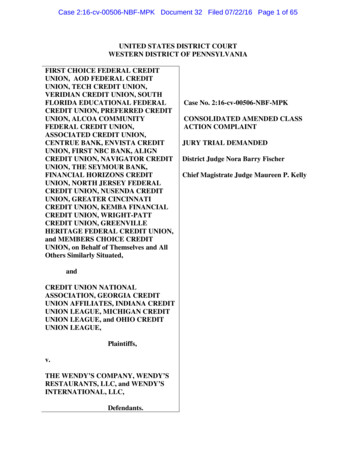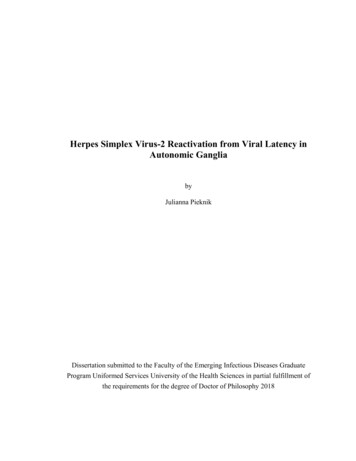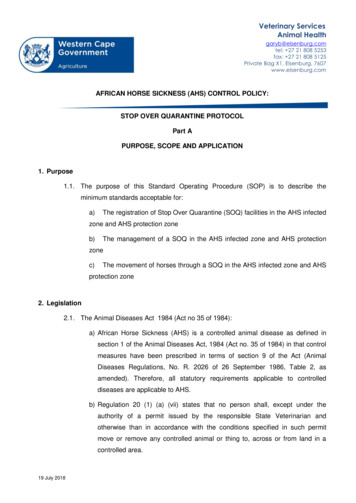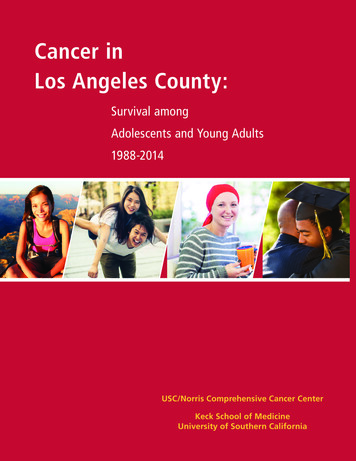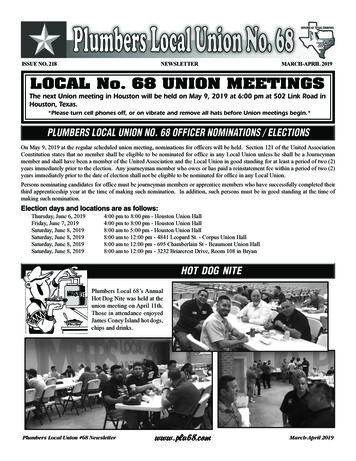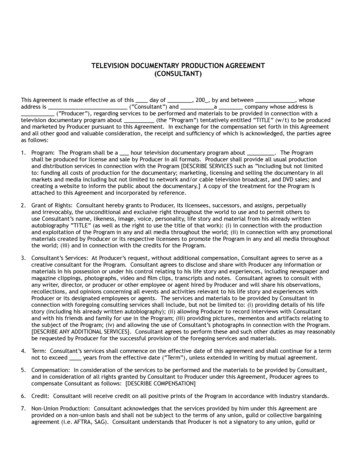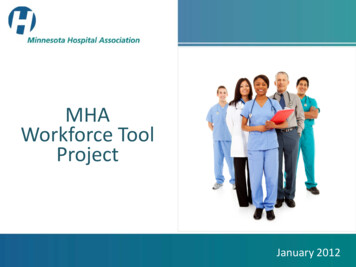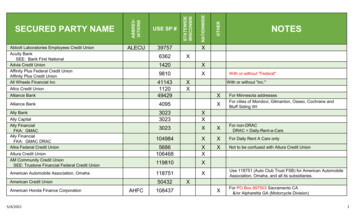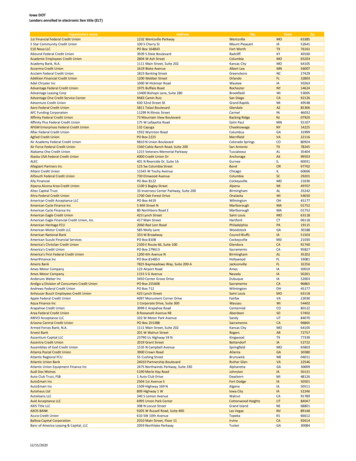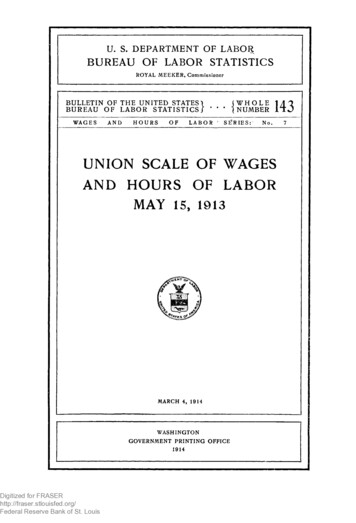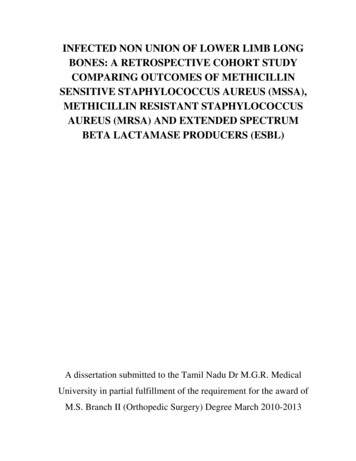
Transcription
INFECTED NON UNION OF LOWER LIMB LONGBONES: A RETROSPECTIVE COHORT STUDYCOMPARING OUTCOMES OF METHICILLINSENSITIVE STAPHYLOCOCCUS AUREUS (MSSA),METHICILLIN RESISTANT STAPHYLOCOCCUSAUREUS (MRSA) AND EXTENDED SPECTRUMBETA LACTAMASE PRODUCERS (ESBL)A dissertation submitted to the Tamil Nadu Dr M.G.R. MedicalUniversity in partial fulfillment of the requirement for the award ofM.S. Branch II (Orthopedic Surgery) Degree March 2010-2013
Department of orthopedicsChristian medical college, VelloreCERTIFICATEThis is to certify that the dissertation entitled ‗Infected non union of lower limb longbones: A retrospective cohort study comparing outcomes of Methicillin SensitiveStaphylococcus aureus (MSSA), Methicillin Resistant Staphylococcusaureus (MRSA) and Extended Spectrum Beta Lactamase producers (ESBL)’ is thebonafid original work of Dr Raju L Hadimani submitted in fulfillment of the rules andregulations for the MS orthopedics examination of the Tamil Nadu Dr. MGR Medicaluniversity, to held in April 2013Guide:Dr. Manasseh NityananthAssociate professorDepartment of orthopedics, Unit IChristian Medical College, Vellore-632004
Department of orthopedicsChristian medical college, VelloreCERTIFICATEThis is to certify that the dissertation entitled ‗Infected non union of lower limb longbones: A retrospective cohort study comparing outcomes of Methicillin SensitiveStaphylococcus aureus (MSSA), Methicillin Resistant Staphylococcusaureus (MRSA) and Extended Spectrum Beta Lactamase producers (ESBL)’ is thebonafid original work of Dr Raju L Hadimani submitted in fulfillment of the rules andregulations for the MS orthopedics(Branch II) examination of the Tamil Nadu Dr. MGRMedical university, to held in April 2013This consolidated report presented herein is based on a bonafid IRB approved studyconducted by the candidate himself.Dr. Alfred Job DanielProfessor and HeadDepartment of Orthopedic SurgeryChristian Medical college, Vellore
ACKNOWLEDGEMENTGurur-Brahmaa Gurur-Vissnnur-Gururdevo Maheshvarah Gurure[-I]va Param Brahma Tasmai Shrii-Gurave Namah 1 The Guru is Brahma, the Guru is Vishnu, the Guru Deva is Maheswara (Shiva),The Guru is Verily the Para-Brahman (Supreme Brahman); Salutations to that Guru.Bearing these beautiful thoughts I humbly offer my work at the feet of my parents throughwhom I have felt HIS blessing in every step of my life.I offer my most sincere gratitude to my teacher and guide Dr. Manasseh Nityananthprofessor Department of Orthopedics Unit I, for his supervision, advice and guidance fromthe initiation of the study to the final presentation of the findings. During the study period Ihave been nourished by his teaching skills and rational approach to clinical research. Hisimpression as a great surgeon, empathetic clinician and an ethical researcher will remain forlong time and will help me shape my professional approach as well as intellectualunderstanding.I express my gratitude to my professors Dr Vinoo M Cherian, Dr Alfred J. Daniel, Dr VijayTK Titus, Dr Tilak J, Dr Vrisha Madhuri ,Dr Pradeep, Dr Venkatesh and Dr Kenny S David.For their valuable suggestions and guidance throughout my residency.I also express my gratitude to my professors Dr K S Manjunath and Dr P K Raju who taughtme both orthopedic and life skills.
I thank Dr Vinoo George, Dr Sumant Samuel, Dr Viju Daniel, Dr Justin Arockiaraj, DrVignesh and Dr Korula Mani who taught me orthopedic skills. I also thank my postgraduation colleagues and juniors residents for their cooperation.I thank Mr Rajesh, Mrs Indumathi madam, Mrs Kothai and Mrs Vimala whose role in mythesis has been very crucial. I also thankMiss Tunny Sebastionfor their help inanalysis of my thesis.I thank all my patients who patiently bore with my examinations and history taking.I would not be able to write this page if not for my brother Praju and my friend RajashekharI S who were the umbrella to me during my hardship with their constant support andunconditional love. The credit of this work goes to them.
TABLE OF CONTENTSS.No.ContentPage. No.1INTRODUCTION12AIMS AND OBJECTIVE53LITERATURE REVIEW64MATERIALS AND nt ImagesIRB ClearanceConsentsData sheets83
IntroductionInfected non union of lower limb long bones is one of the most common complicationfollowing fracture especially open fractures in developing country like India. Open fracturewith severe contamination and communition, delay in presentations to hospitals, delay inreferrals to trauma care centre, delayed surgical care results in increased number of infectednon unions especially in femur and tibia.Road Traffic Accidents (RTA) in IndiaWorld Health Organization (WHO) report on road safety reported that India has highestnumber of road accidents. With more than 1million deaths annually India has highest roadtraffic accident rate in world. The risk of being involved in a fatal road traffic crash hasincreased for Indian citizens over the past few years. This increase is attributed to increase inthe number of motor vehicles per capita in India.Main reason of increasing RTA in India speed driving, long distance driving(truckdrivers),drunk and drive, minimal use of helmets, seat belts in vehicles.A study from one of the Medical College from Pondicherry, on road traffic accidents in Indiashowed that working laborers were the highest (30%) among the victims and highest numberof victims (31%) were between 20-29 years of age followed by 30-39 years and 40-49 yearsage group. About 70% of the victims were under 40 years of age (1). The long distance towork place and poor transport facilities make these people at risk to road traffic accidents.1
Industrial accidentsSecond cause is industrial accidents. In India where economy is growing fast but oureducations system at primary and secondary level is still lagging behind so unemploymentand illiteracy dominates among industrial workers and labors, there is small role forergonomics, lack of proper training, poor safety measure at work place, long duration ofwork and lack of concentration while working complicate in accidents.Cigarette smoking has been shown in numerous clinical and experimental studies to have anadverse effect on fracture-healing (3) . Smoking places the patient at a risk of delayed unionand increases the rate of complications. Previous smoking history also appears to increase therisk of osteomyelitis and delayed time for union (4).Infected non union of the lower limbs is significant problem both to patients and treatingorthopedician. In many instances patient had already undergone multiple surgical procedure,lost his or her considerable money and time, lost his job, alter his life style, sad anddepressed. Multiple surgeries are not only physical trauma but also psychological . Theproblems faced by treating orthopedician are not less.Infection with polymicrobial organism, multiple scars of old surgeries, contractures of skinand soft tissue, edema, poor neurology and vascular supply, persisting draining sinuses andosteoporosis of bonefurther compromise and complicate the surgical planning andprocedure.2
Persisted infection, deformity, shorting of the limb, joint stiffness disability complicates thenon union. Conventional method of treatment of infected non union includes extensivedebridement and soft tissue coverage with flaps and or skin graft, antibiotic impregnatedbeads packing in the defect to increase the local concentration of the antibiotics withoutsystemic side effects, papineau open cancellous bone grafting, free tissue transfer addressesboth non union and infection . Secondary procedure are usuallyrequired to correctdeformity, bone loss, shortening, joint contracture and to provide stability.Most of these challenges are addressed by Ilizarov and to some extent by limb reconstructionsystem(LRS).Evidence has been accumulating that infections produced by Methicillin-resistantStaphylococcus aureus(MRSA) are more virulent and more deeply invasive than thoseproduced by Methicillin-sensitive Staphylococcus aureus(MSSA).Methicillin-resistantStaphylococcus aureus infection is costly to treat, has a high mortality and morbidity andresults in longer hospitalization compared to Methicillin susceptible Staphylococcusinfection(2)Currently there are no studies which focus on organisms and the clinical, functional andradiological out comesin infected non union of long bone but it has been studied inmusculoskeletal infections in general. Musculoskeletal infections caused by MRSA areassociated with a longer hospital stay, a greater number of surgical interventions higher3
complication and mortality rates than those caused by MSSA, as well as with higher rates ofdeep venous thrombosis, septic pulmonary emboli and abscess formation.There are no studies in the literature which compares organisms involved in infected nonunion of lower limb long bones and their clinical, functional and radiological outcomes.This has been well documented in periposthesis infection and joint infections that MRSA areassociated with a longer hospital stay, a greater number of surgical interventions, highercomplication and mortality rates than those caused by MSSA . The role of the ESBL is alsonot well documented.4
Objectives and aims of study(A) To determine the clinical, functional and radiological outcomes of infected non unionof lower limb long bones treated in Christian Medical College,Vellore between 2007to 2009 in Department of Orthopedics.(B) To compare the outcomes between Methicillin-sensitive Staphylococcus aureus(MSSA), Methicillin-resistant Staphylococcus aureus (MRSA) and ExtendedSpectrum Beta Lactamase producer (ESBL).(C) To determine whether infections produced by MRSA and ESBL are more virulent,needs multiple procedures , needs more debridement, more time to union and moreduration of hospital stay than those produced by MSSA in infected nonunion of longbone of lower limbs.5
LITERATURE REVIEWDefinitionNon-union of the fracture is defined as the cessation of all reparative processes of healingwithout bone union (5). In 1986, for purposes of testing bone-healing devices, United StatesFood and Drug Administration panel defined nonunion as ―established when a minimum of 9months has elapsed since injury and the fracture shows no visible progressive signs ofhealing for 3 months.‖ This criterion cannot be applied to every fracture, however. A fractureof the shaft of a long bone should not be considered a nonunion until at least 6 months afterthe injury because often union requires more time, especially after some local complication,such as an infection(6).Infected nonunion has been defined as a state of failure of union and persistent infection atthe fracture site for 6 to 8 months(8). Infected nonunion can develop after an open fracture,after a previous open reduction and internal fixation (ORIF) or as a sequel to chronichematogenous osteomyelitis. The open fracture is the most common cause of infectednonunion and the tibia is the most commonly involved bone in the infected nonunion after anopen fracture(9,10). Because of increased enthusiasm for operative fracture surgery, infectednonunion after implant surgery has nearly equal incidence(9).Factors associated with infectednonunion include exposed bone devoid of vascularized periosteal coverage for more than 6weeks, purulent discharge, a positive bacteriological culture from the depth of the wound,and histologic evidence of necrotic bone containing empty lacunae. Soft tissue loss withmultiple sinuses, osteomyelitis, osteopenia, complex deformities with limb-length inequality,6
stiffness of the adjacent joint and polybacterial multidrug resistant infection all complicatetreatment and recovery(9). These factors make an unfavorable milieu for fractureunion(8).Even after prolonged treatment and repeated surgeries to correct this problem, theoutcome is unsure and amputation may be the only alternative left.According to the AO-Principles of fracture management, delayed union describes thesituation where there are distinct clinical and radiological signs of prolonged fracture healingtime. Unless there is bone loss, a non-union is usually declared between 6 and 8 monthsfollowing the fracture. Pseudarthrosis is defined as formation of a false joint where afibrocartilaginous cavity is lined with synovium producing synovial fluid(7).The diagnosis of non-unions is based on clinical symptoms and physical findings includingpain at the fracture site and evidence of pathologic motion, as well as the radiological signsthat appear during the course of treatment. The radiological signs depend on the type of nonunion.They are generally indicated by the absence of bone bridging between the fragments,persistent fracture lines, sclerosis at the fracture ends, a gap, and hypertrophic or absentcallus(7). Final stage of a nonunion is formation of pseudoarthrosis. For radiographicassessment anteroposterior, lateral and oblique views are used.7
EtiologyAs fracture repair is a continuous process, many biologic and/or mechanical factors play asignificant role in the consolidation of a fracture. Non-union may occur either as a result of apoor mechanical or biological environment at the fracture area or as a combination of thetwo.Generally, disturbed vascularity and instability are the most important factors leading to anon-union.The biologic factors are related more to vascularity. Inadequate blood supply can be causedby trauma or surgical disruption or by instability at the fracture site. Open fractures,especially severe grades II and III, or unstable fractures from high energy trauma, are at highrisk of developing into a non-union because of unfavourable biologic environment. Poorhealing rates also apply to fractures where the bone has inadequate soft tissue coverage, andin conditions, which include bone loss, infection and diminished blood supply. Another causeof fragment avascularity is open reduction of a fracture with wide stripping of the periosteumand damage of the bone and soft tissue blood supply during internal fixation.Instability at the fracture site is the principal mechanical factor that leads to non-unions.Inadequate immobilization or poor external or internal fixation allows excessive motion atthe fracture site. This motion creates initially high strain to the local precursor cells, whichare later sensitised by biochemical mediators so that activation and proliferation occur.Generally, the amount of strain affects the multi-stage and multifaceted bone healing processunder the control of a mediator system(10).8
Local factors were defined in a review at this clinic of 842 patients with nonunions of longbones. Boyd found that nonunion was more common when the fractures were (a) open; (b)infected; (c) segmental, with impaired blood supply, usually to the middle fragment; (d)comminuted by severe trauma; (e) insecurely fixed; (f) immobilized for an insufficient time;(g) treated by ill-advised open reduction; (h) distracted either by traction or by a plate andscrews; or (i) of irradiated boneGeneral factors such as old age, cachexia, malnutrition, anti-inflammatory agents,anticoagulants, steroids, burns and radiation may be contributory, but are not the main causesof nonunion(11).Cigarette smoking was associated with a higher risk of delayed union, non-union and othercomplications in patients who smoked compared to non-smoker with open tibialfractures(12).Additionally, nonsteroidal antiinflammatory drugs (NSAIDs) have been found to decreasefracture healing in multiple animal studies. Several studies have found delayed healing inhuman subjects who were taking NSAIDs, whereas many other studies refute the hypothesisthat NSAIDs delay fracture healing. At best, the literature is still conflicting concerning theinfluence of NSAIDs on fracture healing9
PATHOGENESIS (13)In a nonunion, the normal fracture repair process occurs only minimally, is interrupted, ordoes not result in the formation of bridging bone; instead it produces only fibrous tissue orcartilage, which is interposed in the fracture site in the absence of bony callus bridgingbetween the two major fracture fragments.Unless obscured by overlying hypertrophiccallus, a radiolucent line representing the zone of fibrous and/or cartilaginous tissue isevident on plain radiographsWhen a nonunion is characterized by the production of cartilage in the presence of significantmotion, often a cleft will develop in the cartilage. The surrounding fibrous tissue forms apseudocapsule; with sealing of the bone ends and remodeling, a false joint, or pseudarthrosis,is formed. A serum transudate is usually found in these pseudarthroses, which is evidentupon incision through the fibrous capsule into the pseudarthrosis as normal-appearing jointfluid exudes forth. Atrophic and oligotrophic nonunions are characterized by minimal or noformation of cartilage, a predominance of fibrous tissue formation, and what appears to be anaggressive osteoclastically mediated resorption of the bone ends, resulting in a pencil-likeconfiguration of the ends of the major bone fragments. In part, this picture may be caused byactual mechanical erosion of the bone ends resulting from weight bearing or excessivemotion. This picture is more common in the presence of pathologic nonunions, such as incongenital nonunions associated with neurofibromatosisInfection, per se, does not cause nonunion, as union has been shown to occur in the presenceof active infection. Uncontrolled infection, however, causes nonunion, predominantlybecause purulent material dissects under pressure within the intramedullary canal and along10
the subperiosteal surfaces of bone, resulting in bone necrosis. The inflammatory response tothe infectious process may also lead to an excessive remodeling response causing osteolysis,which further slows the rate of union.The initial event of infection occurs when bacteria successfully lodge on or near the bone orimplant. The easiest and most common access for bacteria is the surgical wound. Theyflourish in this environment because trauma to the tissues by the surgery, causes some tissuenecrosis is due to direct trauma, compromises the blood flow to the tissues and results inhematoma formation. The presence of the large foreign body provides a surface for thebacteria to adhere to.The other routes bacteria may take to reach the area are hematogenous seeding andcontiguous spreading from adjacent areas of infection. The hematogenous spread of bacteriahas been associated with chronic skin lesions, dental manipulation, urinary infection,diabetes, and other chronic diseases. One of several scenarios may take place once thebacteria have gained entry to the area. Bacteria may be destroyed by the host, live insymbiosis with the host, or flourish, causing local infection, host sepsis, and even death.The body's first response to bacterial invasion is an acute inflammatory reaction. A myriad ofcomponents are involved in this process, including polymorphonuclear cells, chemotacticfactors, and the immune system. Leukocyte diapedesis occurs, followed by infiltration ofpolymorphonuclear cells to the area. The process in which polymorphonuclear cells areattracted to the area by chemical substances is known as chemotaxis.11
The immune system is composed of cell-mediated and humoral components. Both cellmediated and humoral responses are activated to fight bacterial infections. Once thepolymorphonuclear cells attack bacteria, some may be damaged, thus releasing additionalchemotactic molecules that attract even larger numbers of polymorphonuclear cells. Whenthe polymorphonuclear cells are in proximity to the bacteria, the particles are phagocytosed.For phagocytosis to occur, opsonins or components in the serum must coat the bacteria,making them more attractive for the macrophage.Elderly patient, may be particularly susceptible to infection because their immune systemsare compromised. With increasing age, the immune becomes less competent. These changesinclude atrophy of the thymus (the site of T-cell maturation), a decreased ability to mount adelayed-type hypersensitivity to various stimuli, and a generalized decreased ability oflymphocytes response to respond to foreign stimuli.The nonspecific immune response can be affected not only by activation of the complementsystem but also by certain medications. Nonsteroidal anti-inflammatory agents, steroids, andaspirin are common medications that suppress the immune response.12
CLASSIFICATIONS(I)Weber-Cech classification(according to the viability of the ends of the fragments)(21)Hypervascular nonunions(capable of biological reaction ) subdivided :1.Elephant foot: rich in callus, caused by mechanical instability. Increasing themechanical stability of the fracture site will often permit these to heal2.Horse hoof: mildly hypertrophic and poor in callus. Typically occur after amoderately unstable fixation with plate and screws. The ends of the fragments showsome callus, insufficient for union, and possibly a little sclerosis.3.Oligotrophic : not hypertrophic, but are vascular, and callus isabsent. Theytypically occur after major displacement of a fracture, distraction of the fragments, orinternal fixation without accurate apposition of the fragments.13
The second type of nonunion is avascular ( incapable of biological reaction),a poor bloodsupply in the ends of the fragments, subdivided as follows:1.Torsion wedge: characterized by the presence of an intermediate fragment in whichthe blood supply is decreased or absent. The intermediate fragment has healed to onemain fragment, but not to the other.2.Comminuted : characterized by the presence of one or more intermediate fragmentsthat are necrotic.3.Defect: characterized by the loss of a fragment of the diaphysis of a bone. The endsof thefragments are viable, but union across the defect is impossible.4.Atrophic :These usually are the final result when intermediate fragments are missing,and scar tissue that lacks osteogenic potential is left in their place. The ends of thefragments have become osteoporotic and atrophic(II)Gordon and chiu (severity of underlying bone damage)(22)Type A: tibial defect and non union without significant segmental lossType B:tibial defect more than three centimeter long with intact fibulaType C:tibial defect more than three centimeter long involving both tibia and fibula(III)May and Jupiter(status of tibial bone after soft tissue and skeletaldebridment)(23)Type I: intact tibia and fibula capable of withstanding functional load. Localized softtissue loss, unicortical skeletal involvement with little or no threat to the skeletal14
integrity, rehabilitation is six to twelve weeks type II : intact tibia with bone graftneeded for the structural support tibia is still intact but weaken by debridment andmay fracture by physiological loadType III: tibial defect six centimeter or less with intact fibulaType IV :tibial defect more than six centimeter with intact fibulaType V : tibial defect more than six centimeter and no usable intact fibula(IV)Paley et al. (classification of nonunions of the tibia , can be applied to otherbones).(24)They divided nonunion, clinically and radio graphically, into two major types :Type A: nonunion with bone loss of less than 1 cm. subdividedType A1: mobile deformity and those with aType A2: fixed deformityType A2-1: stiff nonunion without deformityType A2-2: stiff nonunion with a fixed deformity.Type B : those with more bone loss more than 1 centimeterType B : non unions with a bony defect ,Type B2: loss of bone lengthType B3: both bony defect and loss of length modified further by the presence orabsence of infection.15
(V)Anil K. Jain(according to the bone gap and severity of Infection)(25) categorized intofour groups Type A is infected nonunion of long bones with non draining (quiescent)infection, with or without implant in situ.Type B is infected nonunion of long bones with draining (active) infection. Both areclassified further into two subtypes.Subtype 1 is bone gap smaller than 4 cm. Subtype 2 is bone gap larger than 4 cm.The size of the bone gap is assessed after debridement. Patients with wounds that had nodischarge for 3 months were labeled as nondraining (quiescent)Treatment philosophyTreatment of infected nonunion is technically demanding, prolonged, and needs a team.There are two schools of thought in the treatment of infected nonunion.(a) The ‗union-first‘ strategy(b) The ‗infection-elimination first‘ strategy.The first strategy aims at achieving union first and then dealing with the problem of infectionas the problem presents itself. This approach does not aim at eradication of infection as themain objective.The second strategy aims at elimination of infection as the first and major objective and boneunion as the next objective.16
The second strategy is the more popular one.This strategy does have its drawback: bone debridement leads to a defect which dramaticallyincreases the complexity of reconstruction.The strategy has two steps:(a) Radical debridement of necrotic tissue (bone and soft tissue).(b)Reconstruction of bone (to effect union) plus soft tissue (to provide healthy viablecoverage).The bone defect (dead space) that results from bone debridement can be managed byantibiotic-impregnated bone cement. Once infection is eradicated or controlled, the secondstage is commencedThere are four operative techniques (with considerable overlap among them) which havebeen used :(I) Ilizarov.(II) Intramedullary devices with or without the use of external fixator.(III) Free tissue transfer.(IV) In situ reconstruction.17
Bone results are, in general, better compared to functional results. Overall, the outcomefollowing treatment of infected nonunion are good to excellentChange in trend of Methicillin-resistant Staphylococcus aureus (MRSA) infectionMethicillin-resistant Staphylococcus aureus (MRSA) was described in 1961, shortly after theintroduction of methicillin, and outbreaks of MRSA were reported in the early 1960s . Sincethat time, MRSA has spread worldwide, and the prevalence of MRSA has increased in bothhealthcare and community settings. For example, the prevalence of methicillin-resistanceamong S. aureus isolates in intensive care units in the United States is 60 percent(26), andmore than 90,000 invasive infections due to MRSA occurred in the United States in 2005(27)DEFINITION — Methicillin resistance requires the presence of the mec gene; strainslacking a mec gene are not methicillin resistant. Methicillin resistance is defined in theclinical microbiology laboratory as an oxacillin minimum inhibitory concentration (MIC) 4mcg/mL(28).Other methods of detection, such as the use of the cefoxitin disk or one ofseveral polymerase chain reactions (PCR) to detect the mec gene, are also used.Isolates resistant tooxacillin or methicillin are also resistant to all beta-lactam agentsincluding cephalosporins. MICs of 4 to 8 mcg/mL are considered to represent borderline orlow level resistance.Evolving epidemiologic observationsThe CA-MRSA and HA-MRSA classifications are no longer distinct, since patients candevelop MRSA colonization in one realm and develop manifestations of infection in another18
The blurring epidemiologic distinction between HA-MRSA and CA-MRSA was alsoillustrated by the United States Active Bacterial Core surveillance network report of 8987invasive MRSA infections in 2005. In this report, the rate of invasive MRSA infection was32 per 100,000, the incidence of MRSA among patients 65 was 128 per 100,000 and themortality rate was 6.3 per 100,000 (29)Is Methicillin-Resistant Staphylococcus aureus More Virulent than MethicillinSusceptible S. aureus?Comparative studies regarding the epidemiology and outcomes of localized orthopedicimplant-related infections stratified by staphylococci or type of orthopedic implant are rareStaphylococcus aureus is a virulent pathogen and the most common cause of surgical siteinfection and also more commonly seen in orthopedic implant related infection and nonunions Methicillin resistance further complicates therapy for S. aureus . The prevalence ofMRSA has increased dramatically since it was first described in the 1960sMethicillin-resistant Staphylococcus aureus (MRSA) is an increasingly common pathogen insurgical site infection (SSI) but the independent contribution of methicillin resistance to theoutcomes for patients with S. aureus infection is unclear because patients who developMRSA infections are typically older and sicker than are patients who develop methicillinsusceptible S. aureus (MSSA) infectionDorota Teterycz(31) studied outcomes of orthopedic implant infections due to differentstaphylococci. There were 44 infections due to MRSA, 58 due to MSSA, and 61 due to19
CoNS. Overall cure was achieved in 57% of MRSA infections, 72% of MSSA infections,and 82% of CoNS infections, after a minimum follow-up of 1 year. In the subgroup ofarthroplasty infections only, cure was achieved in 39% of MRSA, 60% of MSSA, and 77%of CoNS episodes. They concluded that in orthopedic implant infections, S. aureus is morevirulent than CoNS. MRSA has the worst outcome and CoNS the best20
Materials and methodsThis study is retrospective cohort study done on patients with infected non union of lowerlimb long bones, both tibia and femur, treated in Department of Orthopedics ChristianMedical College, Vellore between years 2007 and 2009.Fracture non union was defined according to Dendrinos et al (33) A fracture that has beenun-united for less than six months ( 6months) was defined as non union if the wound wasopen, infected and there was exposed dead bone or metal.A fracture also considered to benon union after six months ( 6months) if there wasclinically apparent motion at the fracture site and d
M.S. Branch II (Orthopedic Surgery) Degree March 2010-2013 . Department of orthopedics Christian medical college, Vellore . bones: A retrospective cohort study comparing outcomes of Methicillin Sensitive Staphylococcus aureus (MSSA), Methicillin Resistant Staphylococcus aureus (MRSA) and Extended Spectrum Beta Lactamase producers (ESBL)' is the

